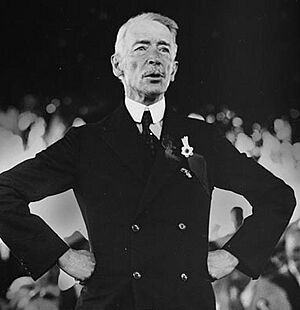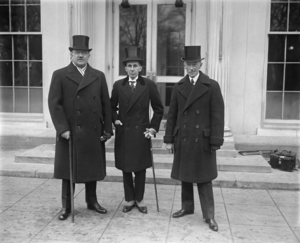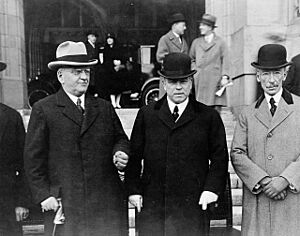Louis-Alexandre Taschereau facts for kids
Quick facts for kids
Louis-Alexandre Taschereau
|
|
|---|---|
 |
|
| 14th Premier of Quebec | |
| In office July 8, 1920 – June 11, 1936 |
|
| Monarch | George V Edward VIII |
| Lieutenant Governor | Charles Fitzpatrick Louis-Philippe Brodeur Narcisse Pérodeau Lomer Gouin Henry George Carroll Esioff-Léon Patenaude |
| Preceded by | Lomer Gouin |
| Succeeded by | Adélard Godbout |
| MNA for Montmorency | |
| In office December 7, 1900 – August 17, 1936 |
|
| Preceded by | Édouard Bouffard |
| Succeeded by | Joseph-Félix Roy |
| Personal details | |
| Born | March 5, 1867 Quebec City, Quebec |
| Died | July 6, 1952 (aged 85) Quebec City, Quebec |
| Political party | Liberal |
| Spouse |
Marie-Emma-Adine Dionne
(m. 1891) |
| Profession | Lawyer |
Louis-Alexandre Taschereau (March 5, 1867 – July 6, 1952) was an important political leader in Quebec. He served as the 14th premier of Quebec from 1920 to 1936. A member of the Parti libéral du Québec, his time as premier lasted almost 16 years. This is the longest time anyone has continuously held the premier's job in Quebec.
Contents
Early Life and Career
Louis-Alexandre Taschereau was born in Quebec City, Quebec. His father, Jean-Thomas Taschereau, was a lawyer and a judge.
He studied law at Université Laval and became a lawyer in 1889. Before becoming premier, he worked closely with Premier Lomer Gouin. He also worked as a journalist and held leadership roles in a bank.
From 1907 to 1919, he was the Minister of Public Works. This job involved overseeing big building projects for the government.
Leading Quebec: Premier Taschereau
Taschereau became Premier in 1920. This was a time when the economy in North America was starting to struggle. These problems eventually led to the Great Depression, a period of severe economic hardship.
Economic Growth and Resources
Premier Taschereau did not agree with some new government programs, like the "New Deal" in the United States. Instead, he strongly believed that private companies should develop Quebec's natural resources. These included the huge forests and mineral deposits in the northern parts of Quebec.
He was a pioneer in using Quebec's many rivers to create hydroelectric power. He knew that Canada did not have a lot of money for these big projects. So, he encouraged companies from the U.S. to invest in Quebec. This helped develop Quebec's industries and aimed to stop people from moving to the U.S. for work.
Social Changes and Challenges
Taschereau's policies aimed to modernize Quebec. This sometimes went against the traditional way of life that the Roman Catholic Church had helped keep in Quebec for a long time. Some groups, like those who wanted to keep old traditions, disagreed with his ideas.

In 1930, Taschereau tried to create a special board for Jewish people in Quebec's education system. This would have given them a say in how schools were run. However, some people opposed this idea. Because of this opposition, the plan was changed. Jewish students continued to attend Protestant schools, and the new board had limited power.
Alcohol Laws and Culture
Another important policy was about alcohol. The government created the Quebec Liquor Commission. This gave the government control over selling alcohol and wine. This happened during a time when alcohol was illegal in the United States, known as Prohibition in the United States.
Taschereau also supported arts and culture. He created Beaux-Arts schools in Quebec City and Montreal. These schools taught fine arts. He also supported scientific and literary works. For his work, he received special awards from France and Belgium.
Political Challenges and Resignation
Towards the end of his time as premier, some members of his own Liberal Party became unhappy. A new group, the Action libérale nationale, broke away from the Liberals. This new party later joined with the Conservative Party of Quebec. They formed a new party called the Union Nationale, led by Maurice Duplessis.
In 1936, Premier Taschereau resigned from his position. This happened after some issues came to light within his government. Another Liberal, Adélard Godbout, became premier. However, two months later, Godbout's party lost the election to the Union Nationale. This ended 40 years of Liberal Party rule in Quebec.
Even after leaving politics, Taschereau served on the boards of several large companies. This showed his continued influence in the business world.
Taschereau won several elections during his time as premier: in 1923, 1927, 1931, and 1935. He resigned in 1936.
Death
Louis-Alexandre Taschereau passed away in Quebec City in 1952. He was buried in the Cimetière Notre-Dame-de-Belmont in Sainte-Foy, Quebec.
See also
- Politics of Quebec
- List of Quebec general elections
- Timeline of Quebec history


